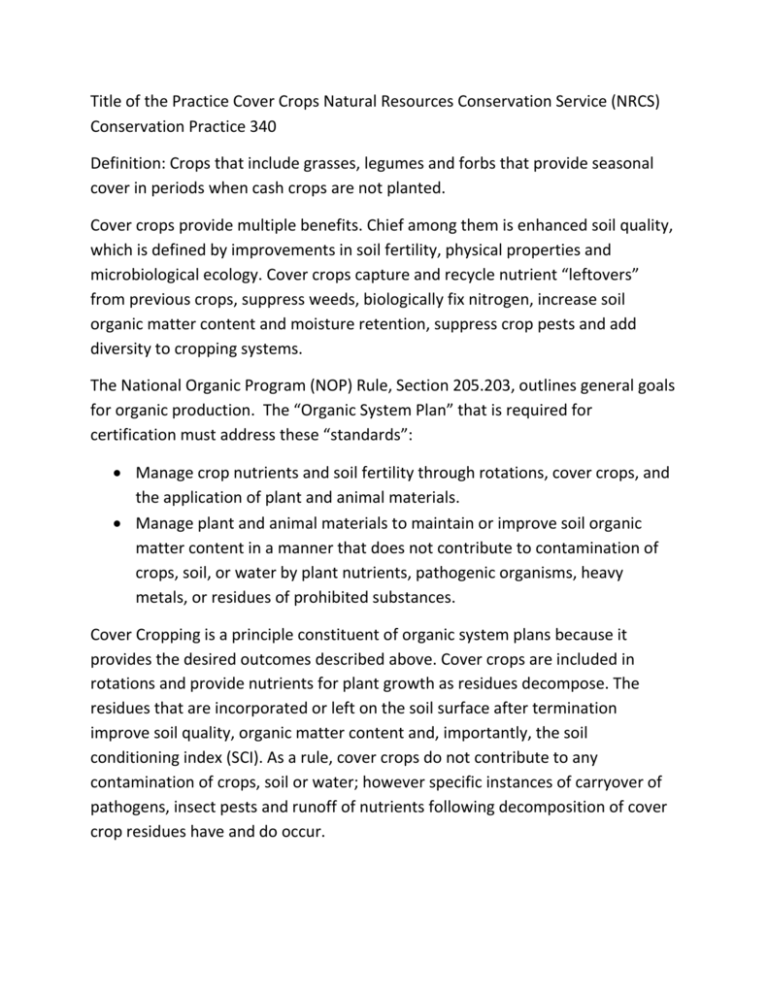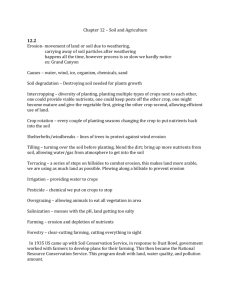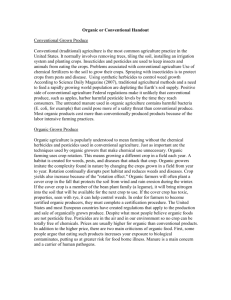Conservation-Practice-cover-crop-rewrite
advertisement

Title of the Practice Cover Crops Natural Resources Conservation Service (NRCS) Conservation Practice 340 Definition: Crops that include grasses, legumes and forbs that provide seasonal cover in periods when cash crops are not planted. Cover crops provide multiple benefits. Chief among them is enhanced soil quality, which is defined by improvements in soil fertility, physical properties and microbiological ecology. Cover crops capture and recycle nutrient “leftovers” from previous crops, suppress weeds, biologically fix nitrogen, increase soil organic matter content and moisture retention, suppress crop pests and add diversity to cropping systems. The National Organic Program (NOP) Rule, Section 205.203, outlines general goals for organic production. The “Organic System Plan” that is required for certification must address these “standards”: Manage crop nutrients and soil fertility through rotations, cover crops, and the application of plant and animal materials. Manage plant and animal materials to maintain or improve soil organic matter content in a manner that does not contribute to contamination of crops, soil, or water by plant nutrients, pathogenic organisms, heavy metals, or residues of prohibited substances. Cover Cropping is a principle constituent of organic system plans because it provides the desired outcomes described above. Cover crops are included in rotations and provide nutrients for plant growth as residues decompose. The residues that are incorporated or left on the soil surface after termination improve soil quality, organic matter content and, importantly, the soil conditioning index (SCI). As a rule, cover crops do not contribute to any contamination of crops, soil or water; however specific instances of carryover of pathogens, insect pests and runoff of nutrients following decomposition of cover crop residues have and do occur. Organic growers primarily use winter annual legume cover crops in rotations to biologically fix nitrogen (N) for subsequent crops. A small grain is often included with the legume in a “biculture” to increase biomass produced and to increase the C:N ratio of the residue. Legume residues decompose rapidly in the spring following termination of the crop (low C:N ratio) which small grain residue decomposes more slowly (high C:N ratio). A higher C:N ratio of the residue resulting from a biculture results in slower decomposition of the residue. Therefore, when the residue is left on the surface, the “mulching” effect lasts longer. And, when incorporated, soil organic carbon content remains higher, longer, enhancing soil microbial activity and soil quality benefits. Organic (and conventional) growers often plant small grain cover crops in fall or early winter to recycle nutrients that remain in soils after harvest. Additional conservation benefits include reducing erosion, biomass production, etc. To capture and recycle nutrients, crops should be established and actively growing before expected periods of rain and related nutrient leaching from the upper soil profile. Select species with superior scavenging capacity and terminate cover crop growth as late as possible. Options for managing cover crop residues are more limited for organic than for conventional growers. Since organic growers cannot use herbicides, no-till production is not yet a viable option. Recent advances in production technologies may lead to increased no-till in both organic field and vegetable crop production systems, but at this time most organic growers manage residues through incorporation. Field preparation can be challenging when cover crop biomass is heavy. Most organic producers raising crops for direct market sale do not have the heavy equipment needed. Getting biomass incorporated with tools not suited to the purpose can be time and energy intensive. Incorporation issues can be addressed through the use of legume monocultures. Crimson clover planted alone can still contribute significant biomass and biomass-N and is relatively easy to kill and incorporate. It is a good choice when experimenting with no-till planting a subsequent crop. Another option for managing cover crop residue is to kill the cover crop early. However, this works at cross purposes with the objective of increasing soil organic matter content. Killing the crop early may make management of the residues easier, but it results in less biomass and biomass-N production. A winter annual cover crop containing a legume/small grain biculture is a fundamental nutrient management tool for organic growers. Hairy vetch, crimson clover and Austrian winter pea are common legume choices for biculture combinations with cereal rye or oats. The latter is the preferred choice before early spring vegetable crops, as is crimson clover, which matures about four weeks earlier than hairy vetch. When termination can be delayed until mid-May, a biculture of rye and hairy vetch will produce the most biomass and biomass-N of any biculture in the Carolinas. However, the availability of equipment on the farm to manage that additional biomass and resulting residue will influence cover cropping decisions. Species, planting date, termination date and weather all influence the amount of N fixed by a winter annual legume. The standard (default) residue values included in the RUSLE2 algorithms may vary considerably from actual results in the field in the Carolinas. To increase soil organic matter content, choose species that excel at biomass production (leaf and root), maximize the growing season by planting as early and terminating as late as possible (taking into account soil moisture depletion and crop insurance parameters) and time of planting for subsequent crops. In summer, given a sufficient window of opportunity, cover crops are grown primarily to recycle nutrients, provide organic matter and prevent erosion. That said, there are summer annual legumes which can fix significant N in a short period of time. Commonly planted summer legumes include cowpeas and soybeans, though the latter is very attractive to deer. These are often grown in a biculture with a short-statured millet such as foxtail or Japanese millet. A relative new choice is sunn hemp (Crotalaria juncea L.) which can fix 100 lbs/A of N in less than 60 days. A primary impediment to the use of sunn hemp has been the cost; however, that price has been coming down, particularly when purchased in bulk quantities. Non-legume choices for summer planting include hybrid sorghum sudangrass and pearl millet. These grasses grow quickly and convert recycled nutrients into abundant biomass. Both can be harvested as forage for livestock. Note that because of the rules regarding preharvest intervals when applying manure, in most cases these forage crops could not be grazed before planting fall crops. Buckwheat is a favorite summer crop on organic farms. Almost all organic farms will include buckwheat in the rotation to attract beneficial insects. Though it doesn’t produce much biomass, that fact that it germinates and establishes quickly (even when surface broadcast) and matures in four weeks makes it a niche “performer” in almost any operation. Organic growers are utilizing cover crops to manage soilborne pathogens and weeds. Cereal rye has proven chemical (allelopathic) and physical properties to suppress or compete with weeds, and leaving residues on the soil surface will both chemically and physically suppress weeds. There is increasing interest in using fall-planted “brassicas”. Brassica spp. and related plants produce glucosinolates, which break down in soil to produce volatile compounds that are toxic to many soil organisms, and have been associated with reductions in soilborne pathogens. Selected Brassica crops, including canola, rape, oilseed radish, turnip, yellow mustard, and white mustard produce these compounds. Two with very high concentrations are Caliente Mustard Blends and Nemat Arugula. These have additional benefits in that they are unlikely to become weeds as they contain no hard seeds. Nemat Arugula can be used as an indicator plant. The leaves will turn red if there are high nematode populations in the soil, if there is low soil P or if residual herbicide is present. Growers planting winter annual cover crops are increasingly including forage radishes in planting mixtures. The thick taproots grow deeply and can breakthrough plowpans, hardpans and other compacted soil conditions. The standard of practice on most organic vegetable farms is to have long rotations. For the most part, however, these rotations are primarily cash crops. Row crops and tobacco have shorter rotations. None of these as a general rule include a sod-based component. When land is taken out of cash crops, it is usually for two years at a maximum. The “rest period” species selected would usually be a multi-species perennial clover/grass combination of some sort. Certified organic producers are required to use organic cover crop seed. When planting legumes, growers must use approved, species-specific, non-GMO inoculants. Organic cover crop seed is considerably more expensive than conventional seed, and transportation costs from certified seed producers are likely to be high. Because many small-scale farms do not have drills, seed is usually broadcast and lightly cover or packed (if at all). For this reason, seeding rates are often 25 to 50 percent higher than those typically recommended. However, drills are now available in the majority of soil conservation districts and can be rented for about $10 per acre.





